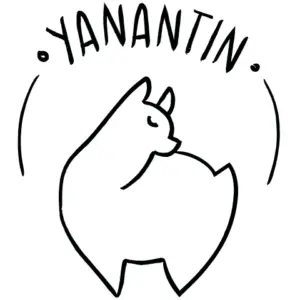I LOOOOOOOVE oversized woolen sweaters. I was the kind of kid who would sit on the couch with my knees folded and my sweater pulled out over them. Not so good for your sweater, because it will stretch OUT and completely deform! How about alpaca wool? Is it stretchy, too?
order prednisone online canada Alpaca wool is stretchy for two reasons: it has natural crimp and a smooth fiber. The smooth fiber texture assures that the wool can move loosely, and the crimp helps put the fabric back into its natural shape (which is the resilience or memory).
So, when you wear an alpaca woolen garment, it will adapt to your body and fit. At the same time, you don’t need to fear that an item will lose its shape after wearing it once, as it will naturally spring back into its original state.
Newport Beach The Alpaca Fiber has Natural Crimp
Fiber curvature is the fancy, more technical word for elasticity, and can be measured by looking at single hairs (compared to staples, which are multiple hairs bundled together). The hair of an alpaca has natural crimp, which means that it has high fiber curvature.
- Crimp is the natural waviness of a fiber and it determines whether the wool is resilient or not.
- Resilience is the elasticity of a wool fiber, and basically shows whether or not a fiber can “bounce back” into place.
- Memory is the degree to which the wool is able to recover after having been stretched (a term mostly used for knitters).
The resilience is dependent on the memory of the wool fiber, which shows how well the fiber is capable of reestablishing its original shape (Referenced from the book: Textiles: A History, by Fiona McDonald).
The combination of these three wool characteristics is important to maintain the quality of a woolen item. Crimp alone is desirable, but without resilience or memory it would not be worth much for long.
- Armadillo Merino made a fabulous fact sheet (see link) in which they talk about the resilience of the merino fiber. While merino is known for its “springiness” (much more so than alpaca), it is still a great resource for learning more about stretchy fibers in general!
Crimp is measured per inch (on a single hair) and then expressed in frequency. You can easily compare it with other fibers by just looking at the number per inch (basically, how many curves on an inch of a hair). Crimp can be more “dented”, meaning that it has a deeper curve (better visible, if you were to take a closer look), which will result in more elastic fibers.
Animal Fibers:
| Alpaca wool | 2-12 crimps per inch |
| Merino wool | Up to 100 crimps per inch |
| Cashmere | 3-4.6 crimps per cm (1.18-1.81 per inch) |
| Silk | No crimp |
Plant Fibers:
| Linen | No crimp |
| Cotton | No crimp |
| Hemp | No crimp |
Synthetic Fibers:
| Nylon | No crimp |
| Polyester | No crimp |
| Rayon (Spandex, Lycra) | Chemically |
As you can see, animal (mammal) fibers tend to have natural crimp, while plant-based fibers (like cotton and linen) do not have any crimp, just like silk. Man-made fibers don’t have any natural crimp, but it can be added chemically.
Hurray for the woolly animals! 🙂
Do All Alpacas Have the Same Amount of Crimp?
Crimp varies per breed of alpaca: suri alpacas have no crimp and huacaya alpacas have regular crimp.
There is actually an important difference between the two types of alpaca that are roaming our planet. One of them is called the Suri alpaca – a funky looking fellow, with beautiful rastafari hair, – and the other one is called the Huacaya alpaca – the well-known teddy bear with a high fluffability rate.
The fiber of the suri alpaca is actually not resilient at all. It has literally 0,0 crimp. Yet, the fiber is incredibly exclusive (according to Wikipedia, only 20% of all alpacas are suris), because it is super lustrous and shiny. Fibers that have little crimp can still be used in wool blends or for weaving.
Elasticity is Important For User-Friendliness & Comfort
Stretch is important when it comes to user-friendliness. Imagine wearing a garment that does not stretch at all: it would barely let you move (at least not without looking like a robot!). Depending on what you’re doing, you will need a different degree of stretchiness in the material, but a minimum is always required.
I actually made a little video to show you how stretchy alpaca wool is:
So, yarn-flexibility is important for making items comfortable. It is also important for durability. Imagine a garment is not at all flexible, a single hook can tear it to pieces (or deform it at least!). Not good, not good.
There are so many different examples that show why flexibility is important (from sleeping to working out… From sitting on your couch to grabbing something from the highest shelf at the supermarket… From hugging someone to sitting cross-legged… Oooh, imagine all of that without being able to move freely!
One way to work around the lack of crimp is by using a knitting pattern, not a weaving pattern, for garments. Weaving with yarns that have no flexibility will work perfectly for placemats, rugs, and sheets (things that you would like to keep in the same shape). For other things, you can totally use low-crimp material for knitting.
Wet Wool Stretches More
When researchers, wool experts or producers test the quality of the wool, they look into two aspects of elasticity: when dry and when wet.
In general, wet wool has more elasticity than dry wool. When wet, wool can be stretched up to 50% of its original length, and when dry, it stretches up to 30% (Referenced from the book: Woven Terry Fabrics: Manufacturing and Quality Management, by Jitendra Pratap Singh, Swadesh Verma).
This means that when a garment gets wet, it gets even more elastic. This is mostly important for manufacturers and knitters, who will need to know how to work with the wool.
For wool-lovers, you don’t need to worry about wearing wool on a drizzly day, as it will most likely not deform your item. But, be careful when you get caught in a raging storm and you are soaked to the bone, because your garment might actually get out of shape because of the weight of the wool (gravity!).
Wool Memory Helps Put It Back in Place
Whenever gravity gets a hold of your sweater and stretches it out, wool memory becomes important. This is the feature that literally remembers the original shape of the wool (closely related to the resilience and springiness of the fiber).
When it comes to alpaca wool, there is a slight difference with other wool types. The elasticity is the same, but as we have seen before, the resilience is the feature of the wool that helps it spring back into shape. And here comes the difference: alpaca wool has slightly less memory than sheep wool, making it thus similar in elasticity and stretchiness, yet a little harder to get back into shape.
What Can Cause a Garment to Lose Its Shape?
Given that wool is elastic, you might wonder whether alpaca woolen items can lose their shape. If you use them normally, your garment will not just change out of nowhere. However, there are circumstances in which a woolen item (especially knitted) can lose its shape:
- When washed roughly
- When hung up to dry when wet
The major reason for woolen items to lose their shape is when they get wet. When they’re wet, their elasticity increases, making it stretch extra. Then, when it is wet, the water gets absorbed making it heavier, which can pull it down. It is important that a garment is put to dry in its original shape.
Getting wet in and of itself is not as much of a problem, as the elasticity will mostly bring it back into shape… HOWEVER, for alpaca wool, which has less memory, this is the moment that the stretch or different shape can become permanent.
This can easily be prevented by laying alpaca woolen garments to dry flat. Ideally on an equal surface, like a table. You can help the drying process by placing the item between two towels and gently pressing the water out. Don’t wring, twist, or rub the garment, as this will increase your chances of ruining your item.
I wrote a Step by Step Guide on How To Wash Alpaca Woolen Products. The drying section is step 3 🙂



